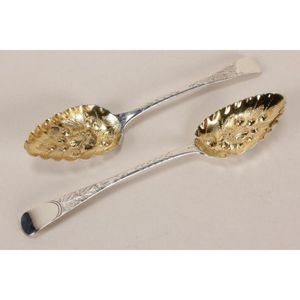Georgian Silver Berry Spoons, 1792 London
You must be a subscriber, and be logged in to view price and dealer details.
Subscribe Now to view actual auction price for this item
When you subscribe, you have the option of setting the currency in which to display prices to $Au, $US, $NZ or Stg.
- Hallmarks - A mark stamped on articles of precious metals in Britain, since the 14th century, certifying their purity. It derives its name from the Guild Hall of the Goldsmiths' Company, who recieved its Charter in 1327 giving it the power to assay (test the purity) and mark articles of gold and silver.
The hallmark will consist of several marks, including the:
- silver standard mark, indicating the purity of the metal. Sterling silver is .925 pure silver.
- the city mark indicating the city in which it was assayed eg London, Birmingham, York etc.
- the date mark, usually a letter of the alphabet in a particular font and case,
- a duty mark, indicating whether duty had been paid to the crown, and only in use from 1784 to 1890
The piece may include an additional mark, the maker's mark, although not forming part of the hallmark, will be located in the vicinity of the hallmarks.
Sometimes silver plated items will bear faux hallmarks, often confusing those not familiar with silver markings. - Crimped - A wavy effect on the the rims or lips of glass or silver vessels. Crimping was frequently used on brightly coloured Victorian glass.
- Engraving - The method of decorating or creating inscriptions on silver and other metal objects by marking the surface with a sharp instrument such as a diamond point or rotating cutting wheel.
- Sterling Silver - Sterling silver is a mixture of 92.5% pure silver and 7.5% of another metal, usually copper. Fine silver is 99.9% pure silver, and is relatively soft and the addition of the very small amount of copper gives the metal enough strength and hardness to be worked into jewellery, decorative and household objects.
- Hammered - A hammered finish on metal wares is achieved by striking the surface of the metal with a hammer to create a series of small, uniform indentations. The indentations can be made in a variety of patterns and depths. The resulting surface texture can vary from a subtle, almost imperceptible texture to a highly textured surface with a strong, pronounced pattern.
The hammered finish adds texture and visual interest to metal objects such as bowls, vases, and other decorative items. It can also be used to add grip or reduce glare on tools, weapons, and other functional metal objects.
A hammered finish can be applied to a range of metals, including copper, brass, silver, and gold. - Georgian - As an English stylistic period, Georgian is usually taken to cover the period from George I (1714) to the Regency of Prince George (1811-20), although the period from 1800 to 1830 is sometimes designated as the Regency period. During the Georgian period the great English cabinetmakers and designers such as Chippendale, Hepplewhite, Adam Sheraton etc., were all active.
Therefore there isn't a single 'Georgian style' as such and to say something is 'Georgian', usually means it was made between 1714 and 1830. This assumes we discount George V and George VI, both being from the 20th century.
The styles popular at the time of each reign were:
George I (1714-1727) saw out the last years of the Baroque period.
George II (1727-1760) reigned during the Rococo period.
George III (1760-1820) saw the last gasp of the Rococo, all of the early Neo-Classic 'Adam style' and most of the later neo-Classic 'Regency style'.
George IV (Prince Regent 1820-1830)encompassed the last of the 'Regency' style.
William IV's reign (1830-1837) was something of a no man's land (stylistically) and he wasn't a 'George' anyway. He covered the last glimmerings of 'Regency' and the start of the 'Victorian' style. - Marrow Spoon - A spoon with a long handle and a narrow scoop shaped bowl, used to scoop and eat marrow from the hollow centre of roasted bones. Some marrow scoops are double ended with a different shaped bowl at each end.
- Embossed / Repousse - Embossing, also known as repousse, is the technique of decorating metal with raised designs, by pressing or beating out the design from the reverse side of the object.It is the opposite of chasing, where the decoration is applied from the front. An embossed or repoussed object may have chasing applied to finish off the design.
This item has been included into following indexes:
- silver cutlery / flatware, patterns - scroll pattern 96
- spoons, silver
Visually similar items


Pair of George IV sterling silver berry spoons, hallmarked, London, 1821, G.N, with tapering handles, decorated with engraved floral motifs, shaped gilt bowls, embossed with fruit and foliage,total weight 95gm, length 22 cm (2)

Pair of George III sterling silver berry spoons, hallmarked, London, 1771, T.D (Thomas Dealtry), with tapering handles, with engraved crest and scroll work, above gilt bowls embossed with fruit, total weight 142gm, length 21 cm (2)

Two Australian silver Wildflower spoons by John Harris, Western Australia. (2) (cased)
